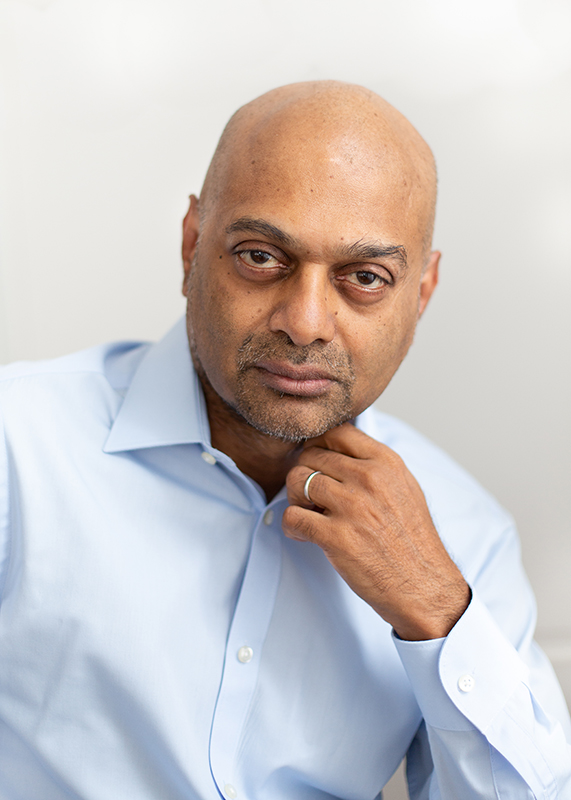Press Release
For Johns Hopkins APL Networking Pioneer Weerackody, Senior IEEE Journal Post Provides the View From Space
For Vijitha Weerackody, a communications engineer at the Johns Hopkins Applied Physics Laboratory (APL) in Laurel, Maryland, his recent appointment as senior editor of the Communication Systems and Networks section of the journal IEEE Transactions on Aerospace and Electronic Systems (TAES) is an opportunity to take a satellite’s view of upcoming innovations in his field.
“It’s quite a thing, to have all the papers that are submitted in this area come across my desk, so to speak,” said Weerackody, currently the technical lead of the Communication and Networking Systems Group in APL’s Asymmetric Operations Sector (AOS). “It gives me a high-level preview of where the field will be four or five years down the road.”
With over 20 patents and 70 peer-reviewed publications to his name, Weerackody has been at the forefront of his field from the beginning of his career. In 1990, he joined the research division of AT&T Bell Laboratories in New Jersey, a lab with a storied history of groundbreaking technical and scientific achievement.
It was the perfect environment in which to spend his formative years. He was able to develop technical expertise in programming, designing and developing satellite communication systems and other networking technologies. At the same time, he cultivated his leadership skills, taking the helm as principal investigator or project manager on most of his work and serving as a mentor to interns and junior staff.
In 2001, at the height of the dot-com boom, Weerackody left Bell Labs to take leadership roles at a series of ambitious but short-lived startups. He continued to contribute to advances in fiber-optics and wireless networking — developing new algorithms, coding techniques and schemes for optimizing networks at scale. In 2004, he also began teaching as an adjunct associate professor of electrical engineering at the University of Pennsylvania.
While Weerackody found the startup world invigorating in many ways, business needs tended to dictate his work, and he missed the intellectual freedom he’d enjoyed as a researcher. So, in 2005, he accepted a position at APL. Fittingly enough, he started at a satellite office, located at a U.S. Army base in Fort Monmouth, New Jersey. When the base closed, APL relocated most of the staff to its main campus in Maryland. Weerackody, a lifelong New Yorker, began working remotely — an unusual arrangement at the time, but one well suited to a world-class expert in telecommunications.
“When Vijitha joined the Lab, he had deep expertise in communications from his time at Bell Labs, but he didn’t have a lot of exposure to military networks,” said Rob Nichols, who hired Weerackody and has supervised a lot of his work at the Lab. “He was able to figure out that satellite communications on the move [SATCOM OTM], on Humvees and other vehicles in extremely dynamic environments, was a major emerging problem for our military sponsors.”
Besides working out how to get finicky satellite systems to function on the battlefield, Weerackody also worked out the problem of SATCOM OTM spectrum sharing with other primary commercial services such as 5G — making it possible for government agencies to share the commercial 5G spectrum without compromising the performance of the primary service. Like many issues in telecommunications, the problem was political as well as technical, as cell phone carriers were less than thrilled at the prospect of sharing networks into which they’d sunk billions of dollars, recalled Mark Simkins, Weerackody’s current program manager in AOS.
“He’s a strategic thinker who can survey the landscape, explore the problem space and identify where the opportunities are,” Simkins said. “Plus, he’s just a funny guy — he’s a New Yorker, so he’s got that New York attitude. I can always count on him to impress sponsors. I attribute a lot of my program’s success to Vijitha.”
Simkins said that Weerackody often has to play the role of diplomat in addition to engineer. Much of his work requires squaring the technical requirements of robust systems with the regulatory framework of the International Telecommunication Union (ITU), the telecommunications agency of the United Nations, as well as military needs, international law and the interests of global corporations. He credits Weerackody with having a rare and valuable blend of technical expertise, leadership ability and street smarts that enables him to analyze complex problems, produce cutting-edge solutions and, crucially, get buy-in from key stakeholders.
Weerackody said that working at APL allows him to tackle deeply interesting problems with kindred spirits.
“What makes APL as an institution is its people,” he said. “I’m surrounded by people who think like me, who are fascinated with advanced technology and are self-motivated, and who are naturally absorbed in their field even on their own time. You don’t find that kind of culture at many places.”
Nichols and Simkins are both happy to see Weerackody in a senior editing role at a key journal in the field. “Vijitha brings an amazing level of rigor to his own work, so he’s someone that’s well suited to digging into the technical and mathematical details of other people’s work,” said Nichols.
“He’s brought a lot of his knowledge of IEEE, and more generally of how standards development works, into my program, which has helped him spearhead some of the critical work we’re doing in 5G,” Simkins said. “I’m happy to reap the follow-on benefits of his editorial work.”
